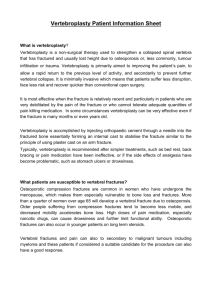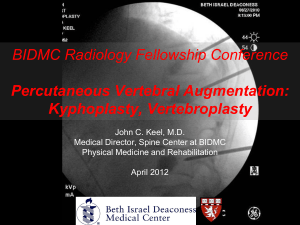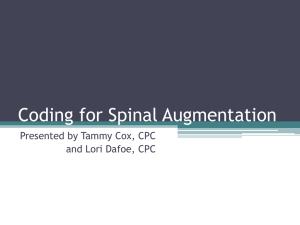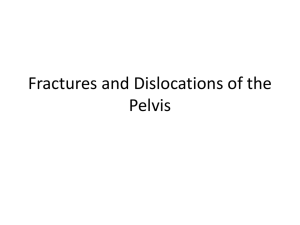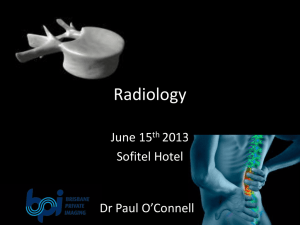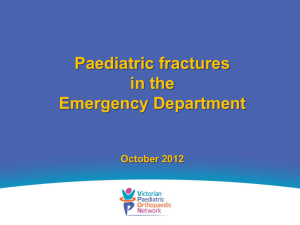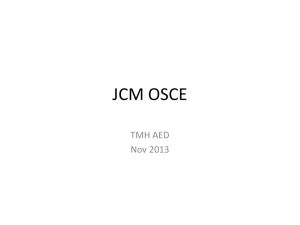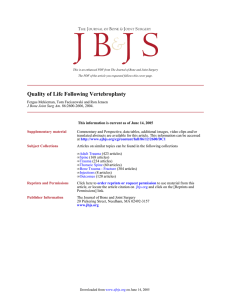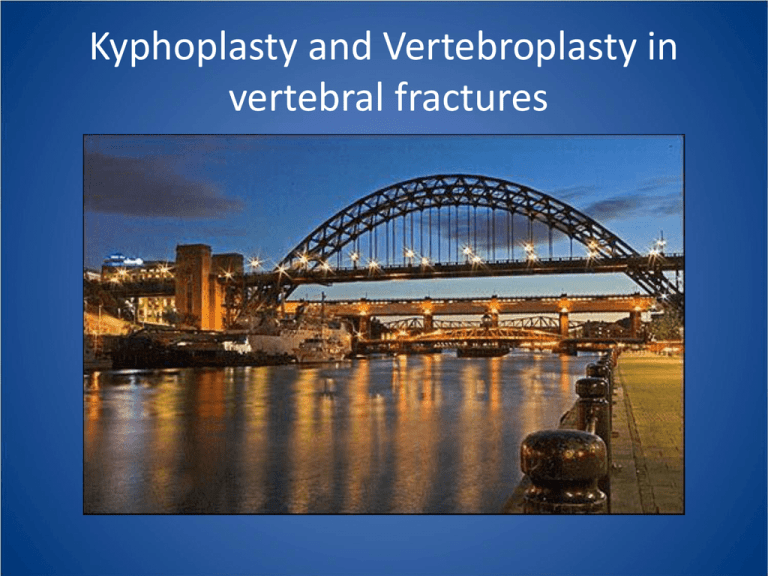
Kyphoplasty and Vertebroplasty in
vertebral fractures
Kyphoplasty and Vertebroplasty
•
•
•
•
•
•
•
Epidemiology of osteoporotic fractures
Natural history
Morbidity and mortality
Conservative treatment
Vertebroplasty/Kyphoplasty
How its done
Selection of patients and imaging
Kyphoplasty and Vertebroplasty
•
•
•
•
•
•
Results
Vertebroplasty v Kyphoplasty
Acute v Chronic fractures
Controversies
Other indications
Future developments
Epidemiology
Radiographic
• 25 % in post
menopausal females
• 40% in women > 80yrs
• Age group 65 yrs+ are
fastest growing
segment of the
population
• Less common in men
•
Melton et al. Epidemiology of vertebral
fractures in women. Am J Epidemiol 1989;
129:1000-11.
Consequences of vertebral
fractures
• Sentinel sign of failing
health
• 35-40% increase in
cancer deaths
• 23-34% increase in
mortality rates
• 5yr survival 61% cf. 76%
•
Cooper C et al. Population based study of
survival after osteoporotic fractures. Am J
Epidemiol 1993:137;1001-5.
Clinical incidence
• Majority are
asymptomatic
• Loss of height and
stooped posture
• 23-33% are painful
• Over ⅔rds become
manageable or
asymptomatic in 6-12
weeks
•
Cooper C et al. The epidemiology of vertebral
fractures. Bone 1993-14.611-5
Predictors of fracture
•
•
•
•
•
•
•
Age
Sex
Osteoporosis
Inactivity
Smoking
20-30% are multiple
Previous fracture
Predictors of fracture
Predictors of fracture
19.2% of females with a
confirmed incidental
fracture had a second
fracture within one year.
24% of females with two or
more fractures developed a
further fracture within a
year.
Lindsay et al. JAMA 2001; 285: 320-3.
Evaluation
• Severe back pain
• Often no history of
trauma
• Pain is worse upright
• Thoracic kyphosis
• Pain reproduced by
pressure over spinous
process
• Very rare neurological
deficit
• Exclude other causes
Evaluation
Think twice!
• Fractures above T6
• Less than 55 yrs without
history of trauma
• Patients with known
malignancy
Radiographic evaluation
of age of fracture
• Plain films
• MRI
Low signal T1
High signal T2
High signal STIR
Best indicator of age is the
history.
Bone Scan
• Not as commonly used
as MRI
• Been show to have a
93% predictive value in
vertebroplasty!
• May be abnormal when
MRI is normal
•
Maynard et al. Value of bone scan imaging
in predicting pain relief in vertebroplasty.
AJNR 2000;21:1807-12.
Treatment
•
•
•
•
•
Pain relief
Exercise
Diet
Osteoporosis
Brace?
Vertebroplasty / Kyphoplasty
What is it?
Vertebroplasty
Kyphoplasty
How does it work?
• Structural support – but no good correlation
with amount of cement injected
• Thermal properties
• Decompression
• Placebo
How is it done?
• Usually performed under
general anaesthetic
• Can be performed under
local
• Day case procedure
• Minimal invasive
How is it done?
How is it done?
How is it done?
Vertebroplasty
Kyphoplasty
How is it done?
Indications for
vertebroplasty/kyphoplasty
• Only needed in a small
subset of patients
• High signal on STIR.
• Pain on percussion
• Increased activity on
bone scan
• T5 and belowkyphoplasty
• Timing?
Contraindications
• Infection
• Uncorrectable
coagulopathy
• Anaesthetic Risk
• Neurology
• Middle column
compromise is NOT.
Complications
• Very few cliniccal relevant complications.
• Cement extravasation 70%+
• Pulmonary embolus 70%+
Results
Vertebroplasty
• Significant better pain and
functional improvement
than conservative
treatment at 3 months.
• No difference at twelve
months.
• Vertebroplasty patients had
significantly more pain than
the conservative group.
•
Hulme PA et al. Vertebroplasty and
kyphoplasty: a systematic review of 69
clinical studies. Spine 2006:31;1983-2001.
Kyphoplasty
• FREE trial.
• 300 patients randomised.
• Assessed at one year
• SF 36 PCS 0-100.
• Kyphoplasty 26 33.4
• Conservative 25.5 27.4
p<0.0001
Wardlaw D et al Lancet 2009;21:1016-24
Controversies
No Benefit
• A Randomized Trial of Vertebroplasty for
painful Osteoporotic Vertebral Fractures
• Buckbinder R et al. NEJM 2009;361:557-568.
• A Randomized Trial of Vertebroplasty for
Osteoporotic Spinal Fractures
• Kalmes DF et al. NEJM 2009;361: 569-579.
• No improvement against sham procedure at 1 week,
or at 1,3 or 6 months.
Controversies
No Benefit
• Previous studies – lack of blinding, lack of true
sham control. Couldn’t exclude a placebo
effect.
• NEJM studies- randomised, blinded and a
sham procedure. Buckbinder needle against
lamina. Kalmes – local anaesthetic around the
facet joint.
Problems
Fracture acuity
Buckbinder: bone marrow oedema indicates
an acute fracture but a detectable fracture
line sufficed for inclusion.
Kalmes only used MRI or Bone scan in which
fracture age was uncertain.
• Both groups had to have a fracture less than a
year old- most groups would use 6 weeks as
an acute fracture definition.
Problems
Enrollment
• Kalmes: 1812 patients initially screened,only
131 entered into study. Most common reason
– patient refusal.
• Buckbinder: Needed 4.5 years in 4 high
volume centres to accrue 78 patients- 141
declined randomisation.
• Pain severity of groups who refused not
reported.
Problems
Control Group
• Is injection of local anaesthetic around the
facet joint a sham procedure?
Vertos II Study
• Prospective randomised trial vertebroplasty v
conservative treatment. 202 patients.
• Results Vertebroplasty had better pain relief at
one year.
• All fractures less than six weeks old.
•
Klazen C et al Lancet 2010:376;1085-1092.
Timing
• The best evidence is that the best results are
achieved within 6 weeks of onset!
• Rarely achievable in the UK
• 50% + get better within 6 weeks
conservatively treated.
• Philosophical when to treat.
• Most fractures treated in UK > 3 months old.
Timing
Older fractures
• No randomised control trials for efficacy of
treatment of old fractures.
• There are trials suggesting similar success
rates to acute fractures of 80% success in
fractures a year or older.
• Brown et al. Treatment of Chronic symptomatic vertebral compression
fractures with percutaneous vertebroplasty . AJN 2004;182:319-312.
My protocol
• Fractures less than 6
weeks old who need to
be hospitilised.
• Failure of conservative
treatment after 3
months
• Vertebroplasty for all
except where middle
column is involved –
Kyphoplasty,
• Bone scan +ve
Vertebroplasty v Kyphoplasty
Vertebroplasty
• Cheaper
• Quicker
Kyphoplasty
• Expensive
• Takes longer
• Restoration of vertebral
height?
• Less adjacent fractures
• Less cement leakage
• Quality of life
Vertebroplasty v Kyphoplasty
A review of 168 studies.
Vertebroplasty
• Mean change in VAS 5.68
• New fracture 17.9%
• Cement leak 19.7%
Kyphoplasty
• Mean change in VAS 4.60
p<0.001
• New fracture 14.1%
p<0.01
• Cement leak 7.0%
p<0.001
•
Comparison of vertebroplasty and
kyphoplasty in vertebral compression
fractures: a meta-analysis of the
literature. Spine J 2008;8:488-97.
Other Uses
• Tumours
• Trauma
• Myeloma
Other uses
• Sacroplasty
• Sacral insufficiency
fractures
• Best performed under
CT guidance.
Developments
• Calcium phosphate in
young patients with
traumatic fractures
• Prophylaxis
• Adding chemotherapy
agents or radioactive
isotopes to the cement
in tumour
Conclusions
• Vertebroplasty/Kyphoplasty is useful in the
treatment of vertebral osteoporotic fractures
although some controversy still exists.
• Low morbidity
• Should be considered in painful fractures over
6 weeks old.

